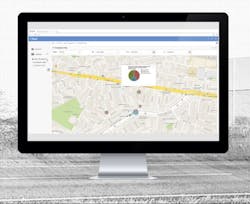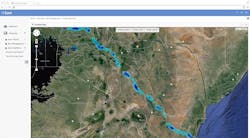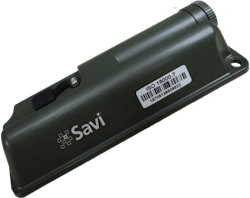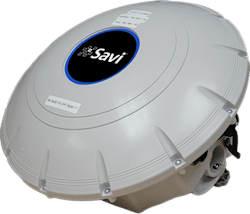Sensor data analytics and Internet of Things boost operational intelligence
In the early 1990s, ineffective supply chain practices left an abandoned “Iron Mountain” of cargo in the desert, leaving warfighters in the lurch, wasting resources, and frustrating many in the military and private sectors. Today, however, aerospace and defense organizations can tap the latest technologies to manage risk and optimize performance across global supply chains.
Many public and private organizations are implementing cutting-edge predictive technologies that use historical sensor data to predict future outcomes, affirm officials at Savi Technology, a provider of sensor technology and sensor data analytics solutions in Alexandria, Virginia. Savi leverages “machine-to-machine (M2M) data and the Internet of Things (IoT) to provide operational intelligence to organizations,” describes Rosemary Johnston, who served more than 20 years in the U.S. Air Force and is now vice president of operations at Savi Technology.
Aerospace and defense end users, including warfighters, have got to have the right part at the right time. They’ll order again and again until they have the asset in hand, which can result in excess inventory, Johnston says. It is, instead, more efficient to use predictive analytics and in-transit visibility, identification at key checkpoints – so end users receive what they need and organizations can stop buying excess inventory.
The Iron Mountain of Assets was the result of not having an accurate estimated time of arrival (ETA) for shipments by air, sea, and land. It is no longer an issue for the U.S. Department of Defense (DOD) and North Atlantic Treaty Organization (NATO) allies, Johnston says. Greater adoption of sensors, increased use of devices on in-transit shipments, and a better understanding of sensor analytics, including predictive analysis, combine to deliver a predictable supply chain that effectively reduces those excesses.
“One of the biggest problems is understanding where things are getting hung up in the supply chain,” such as routes that are tricky to navigate, natural disasters (floods, earthquakes, etc.), and challenges faced in areas of conflict, Johnston explains. “It is important to take data from sensors and apply predictive analytics” to determine, for example: where a tamper or a breach might occur because of the nature of the routes they are traversing, how long it will take to get from point A to point B with the possibility of a natural disaster, or the probability that a shipment will be intercepted and usurped. “Analytics around the data provide insight into the challenges they face and provide solutions,” she adds.
For example, Savi assisted a customer in delivering assets in the challenging area that is Pakistan. Savi experts gained information from tags deployed on items in transit, applied sensor analytics technologies, and through predictive analytics provided information around the location of choke points, including where the shipment(s) would run into delays and how it would affect the time of arrival at the client location.
“The DOD has mandated use of Savi sensors on shipments to NATO allies,” Johnston explains. Sensors are transponders that fit on container; the transponder is commissioned, so it sets up a relationship between what is being shipped and the device. The technology enables tamper alerts to be set up on sensitive shipments – if the door is opened, the shipment suddenly gets too hot (humidity or temperature), experiences a sudden shock (container of electronic components you don’t want dropped from a high height dropped).
“As the container shipment or vehicle exits the gate, it goes past a read station at the port; it gets to the next location and passes a read station; throughout the journey, the shipment encounters read stations. Savi then triangulates the information from the radio-frequency identification (RFID) network,” Johnston describes. “On the high level, we can see where the asset is; on a micro level, we can see the conditions the container encountered along the way, including excessive dwell times.”
The ability to find out what happened at a particular point in time, as well as to reduce dwell times and other risks, helps customers – from prime contractors to airframe manufacturers – quickly understand the value and power of information, Johnston says.
“Power is in the data. Realize the capabilities of information available today, harness that information and the power of data and Internet of Things,” Johnston recommends. “Challenges continue to develop but folks have data available today that, with predictive analytics to help strip out the essential information, can solve their challenges. Customers can use the data we have gained from areas we’ve transited to build predictive scenarios, and they don’t have to invest in anything new. That’s what we’re leveraging – showing them the power of what they already have.” Many organizations already have the data, and don’t need to make a huge investment to strip out and use key information, and oftentimes that hastens the adoption of predictive analytics and the IoT.
Savi leverages more than 25 years’ of sensor technology and military logistics expertise to provide sensor analytics solutions that create operational intelligence from the Internet of Things. Applying big data technologies to machine-generated data, Savi solutions power a large, complex asset tracking and monitoring network, serving the U.S. DoD, Allied military, and more than 1,000 commercial companies around the world.
Savi harnesses predictive analytics, IoT, and Big Data to glean intelligence from sensors deployed to provide additional value to aerospace and defense organizations. Savi technology supported NATO Allies’ Product Director Automated Movement and Identification Solutions (PD AMIS) mission, which deployed in 52 countries to monitor more than 4 million sensors, including 4,600 read/write sites and 32,000 mobile readers.
Savi’s solutions can determine:
- Where the greatest need is for predictive analytics among government organizations
- How they can increase efficiency based on historical data that they already have
- The most volatile routes along the weapons supply line in war zones to increase security and minimize risk
- When to send in the reinforcements: determining a predictable ETA for the arrival of high-value resources
- Optimizing checkpoint arrival time at rendezvous points based on historical data
- The rise of the Internet of Things (IoT) and connected devices creating an opportunity to pull in cheap sensor and telematics data for unparalleled analysis
You might also like:
Subscribe today to receive all the latest aerospace technology and engineering news, delivered directly to your e-mail inbox twice a week (Tuesdays and Thursdays). Sign upfor your free subscription to the Intelligent Inbox e-newsletter at http://www.intelligent-aerospace.com/subscribe.html.
Connect with Intelligent Aerospace on social media: Twitter (@IntelligentAero), LinkedIn,Google+, and Instagram.
Intelligent Aerospace
Global Aerospace Technology NetworkIntelligent Aerospace, the global aerospace technology network, reports on the latest tools, technologies, and trends of vital importance to aerospace professionals involved in air traffic control, airport operations, satellites and space, and commercial and military avionics on fixed-wing, rotor-wing, and unmanned aircraft throughout the world.

Courtney E. Howard | Chief Editor, Intelligent Aerospace
Courtney enjoys writing about all things high-tech in PennWell’s burgeoning Aerospace and Defense Group, which encompasses Intelligent Aerospace and Military & Aerospace Electronics. She’s also a self-proclaimed social-media maven, mil-aero nerd, and avid avionics and space geek. Connect with Courtney at [email protected], @coho on Twitter, on LinkedIn, and on Google+.










